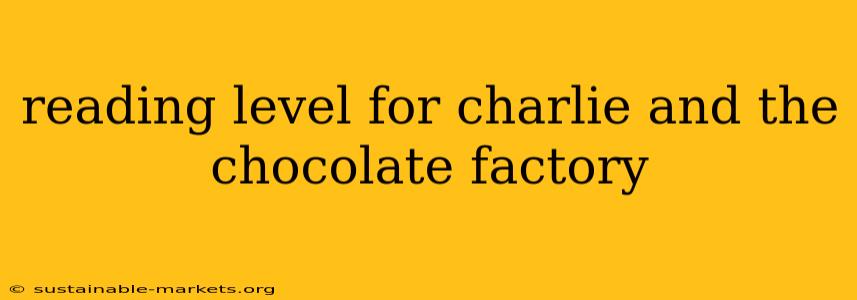Roald Dahl's Charlie and the Chocolate Factory is a beloved children's classic, captivating readers young and old with its whimsical characters and fantastical setting. But determining its precise reading level isn't as simple as assigning a single number. This guide delves into the various factors influencing reading level assessments and provides a comprehensive understanding of the book's suitability for different ages and reading abilities.
Factors Affecting Reading Level Assessments
Several factors contribute to the complexity of determining a book's reading level:
-
Lexile Measure: This widely used metric analyzes sentence length, word frequency, and syllable count. While helpful, it doesn't fully capture the nuances of language, humor, or narrative structure. Charlie and the Chocolate Factory typically falls within the 4th-6th grade Lexile range, but this is just one piece of the puzzle.
-
Flesch-Kincaid Grade Level: Another common readability test, the Flesch-Kincaid score considers sentence length and syllable complexity. Similar to the Lexile score, it offers a numerical representation but doesn't account for the story's overall complexity or thematic elements.
-
Vocabulary: Dahl utilizes a rich vocabulary, including descriptive words and playful neologisms (newly coined words). While many words are easily understood within context, some might challenge younger readers.
-
Sentence Structure: Dahl employs varied sentence structures, ranging from simple declarative sentences to more complex and evocative phrasing. This adds to the book's richness but can also increase difficulty for less experienced readers.
-
Narrative Complexity: The story itself unfolds with a blend of fantastical elements, social commentary, and character development. Younger children might grasp the basic plot easily, but understanding the subtler themes and character motivations requires a higher level of comprehension.
-
Theme and Concepts: The book touches upon themes of poverty, wealth, greed, and the importance of family. These themes might require explanation and discussion depending on the child's age and experience.
Determining Suitability: Age and Reading Ability
While numerical reading level scores offer a starting point, the best way to determine suitability is considering the individual child's reading skills and maturity:
Early Elementary (Grades 1-3):
-
Independent Reading: Likely too challenging for independent reading for most children in this age group. The vocabulary and sentence structure might prove frustrating.
-
Shared Reading: Ideal for shared reading experiences with a parent or teacher. This allows for explanations of vocabulary and exploration of thematic elements.
Upper Elementary (Grades 4-6):
-
Independent Reading: Many children in this age group will be able to read Charlie and the Chocolate Factory independently. However, the level of engagement and comprehension will vary.
-
Classroom Setting: An excellent choice for classroom read-alouds and discussions, fostering vocabulary development and critical thinking.
Middle School (Grades 7-8):
- Independent Reading: Most middle schoolers can easily read and understand the book independently. The themes and character development become more accessible at this age.
Conclusion: It's More Than Just Numbers
Ultimately, the appropriate reading level of Charlie and the Chocolate Factory depends on the individual child's abilities and maturity. While standardized tests offer valuable insights, parental judgment and observation play a critical role in determining whether a child is ready to enjoy this classic story. Consider your child's reading fluency, comprehension skills, and interest in the themes before deciding. Remember, reading should be an enjoyable experience, and a supportive reading environment is essential for fostering a lifelong love of books.

